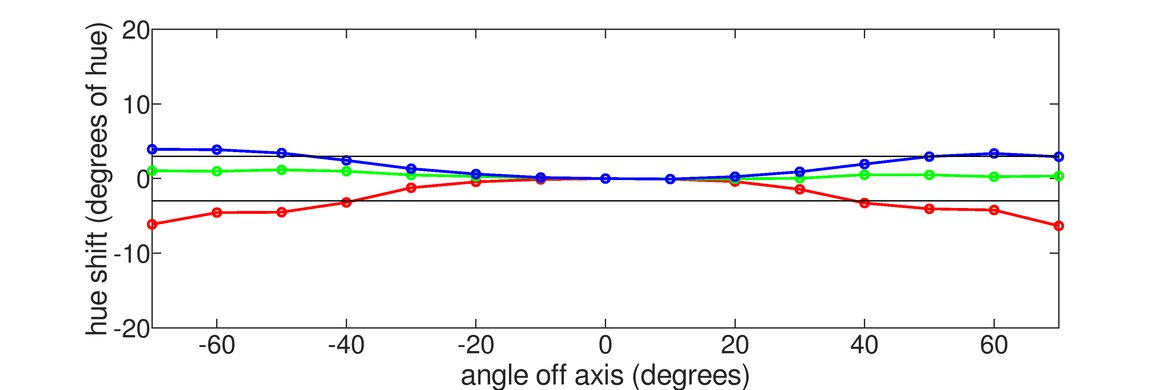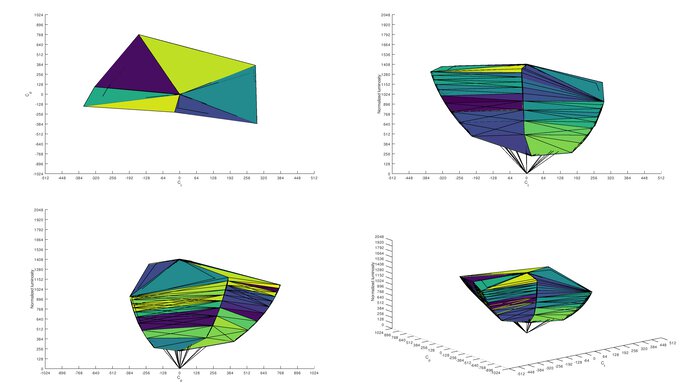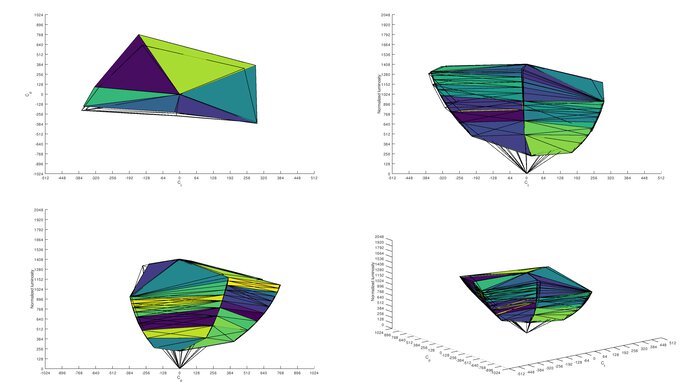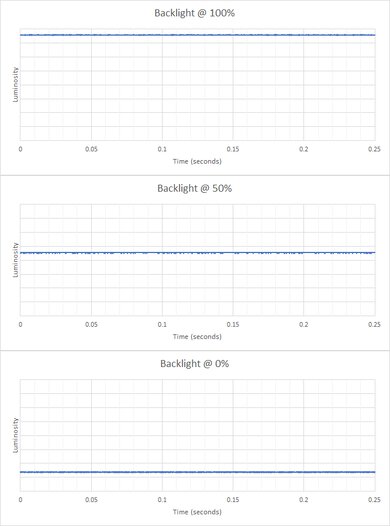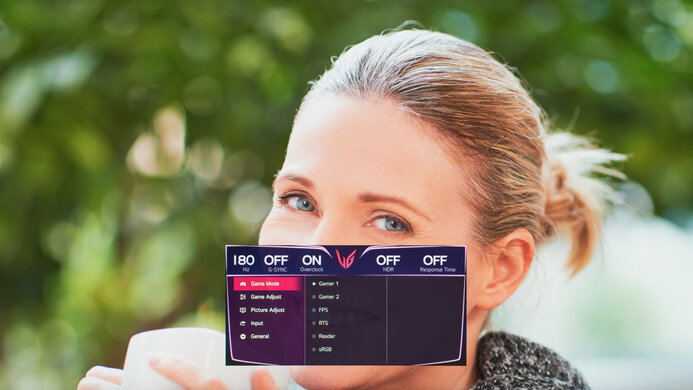The LG 34GP950G-B is a great ultrawide gaming monitor with a 34 inch IPS panel. It's part of LG's popular UltraGear lineup of gaming monitors, delivering an impressive gaming experience with an outstanding response time at the max refresh rate, fantastic low input lag, and a few extra gaming features. It natively supports NVIDIA's G-SYNC variable refresh rate technology, and it also works with AMD's FreeSync technology, but FreeSync doesn't work over HDMI on this model. Like most IPS monitors, it has wide viewing angles but sub-par contrast, so it's not the best choice for gaming in the dark. It does have a local dimming feature that's supposed to improve dark-scene performance, but it's pretty bad, and most people will want to leave it disabled. It looks great in bright rooms, with impressive peak brightness in SDR and decent reflection handling. It's a great choice if you care about accurate colors, as it has amazing accuracy out of the box, a superb SDR color gamut, and incredible gradient handling, with no noticeable banding at all.
Our Verdict
The LG 34GP950G-B is a great monitor overall. It's very good for office use, with a large, high-resolution screen and decent text clarity. It's also a very good choice for watching movies, and it's great for media creation, with a wide color gamut and superb gradient handling. It's an impressive gaming monitor with low input lag, an outstanding response time at the max refresh rate, and a few extra gaming features. Although it has a local dimming feature, it's pretty bad. It also has low contrast, so it's not a good choice for a dark room.
- Low input lag.
- Impressive peak brightness.
- Image remains accurate at an angle.
- Stand can't swivel or rotate to portrait orientation.
The LG 34GP950G-B is a very good office monitor. It offers a great amount of screen space to work with, it has impressive peak brightness and decent reflection handling, so glare shouldn't be an issue. It has good text clarity, although there may be some minor text issues in certain apps. The stand has limited ergonomics, though, so it's not the best for a multimonitor setup. It's great if your work requires accurate colors, as it has amazing accuracy out of the box and incredible gradient handling.
- Excellent gray uniformity.
- Superb SDR color gamut and volume.
- Impressive peak brightness.
- Image remains accurate at an angle.
- Stand can't swivel or rotate to portrait orientation.
The LG 34GP950G-B is an impressive gaming monitor. It has an outstanding response time at the max refresh rate, and even at 60Hz, it's superb. It has fantastic low input lag for a responsive gaming experience. It supports NVIDIA's G-SYNC variable refresh rate technology, and it also appears to work with AMD's FreeSync technology. The large, high-resolution ultrawide screen delivers a more immersive gaming experience, and it has wide viewing angles, which is important if you ever share your screen for co-op gaming.
- Outstanding response time.
- Low input lag.
- Native G-SYNC support.
- Bad local dimming.
- Blacks appear gray in a dark room.
The LG 34GP950G is a very good monitor for watching videos. The large, high-resolution screen delivers a more immersive movie-watching experience, and it has decent viewing angles, so you can watch movies with a few friends without the image degrading for people sitting off-center. It has decent reflection handling but impressive peak brightness in SDR, so glare shouldn't be an issue if you're watching videos in a bright room. It also has excellent gray uniformity and fantastic low input lag. Unfortunately, it's not the best choice for watching in the dark, as it has low contrast.
- Excellent gray uniformity.
- Low input lag.
- Image remains accurate at an angle.
The LG 34GP950G is a great monitor for media creation. The large, high-resolution screen makes it easier to see more of your work at once. It has decent viewing angles, so you don't have to worry about the image degrading at an angle. It also has amazing accuracy out of the box, a superb SDR color gamut with excellent coverage of the Adobe RGB color space, and it has incredible gradient handling. The stand isn't very versatile, though, as you can't swivel it to show it to someone else.
- Excellent gray uniformity.
- Superb SDR color gamut and volume.
- Incredible gradient handling.
- Image remains accurate at an angle.
- Stand can't swivel or rotate to portrait orientation.
The LG 34GP950G-B is a decent HDR monitor. It displays a wide range of colors in HDR and gets bright enough to make highlights stand out. However, it has a low native contrast ratio that makes blacks look gray. While it has a local dimming feature to further improve the black levels, it performs terribly, and there's blooming around bright objects.
- Impressive peak brightness.
- Bad local dimming.
- Blacks appear gray in a dark room.
Changelog
- Updated Apr 18, 2023: Tested the monitor's compatibility with 1440p on the PS5, but it doesn't work.
- Updated Mar 28, 2023: Clarified text throughout as part of Test Bench 1.2, including adding text to the Console Compatibility boxes.
- Updated May 27, 2022: Updated to Test Bench 1.2, resulting in changes to the results and scores with the Response Time and Input Lag. Added tests for Console Compatibility and macOS compatibility and made minor changes to other tests, which you can see in our Changelog.
- Updated Oct 22, 2021: We changed the FreeSync support from 'Yes' to 'Compatible (Tested)'.
Check Price
Differences Between Sizes And Variants
We tested the LG 34GP950G-B 34 inch ultrawide gaming monitor, which is part of LG's UltraGear gaming lineup. There are many other monitors in LG's UltraGear lineup with various configurations, some of which you can see in the table below. As they each have different specs, we don't expect our review to be valid for any of the other models.
| Model | Size | Panel Type | Resolution | Max Refresh Rate | VRR Support |
|---|---|---|---|---|---|
| 34GP950G | 34" | IPS | 3440 x 1440 | 180Hz | G-SYNC (Native) |
| 34GP83A-B | 34" | IPS | 3440 x 1440 | 160Hz | Adaptive Sync |
| 32GP850-B | 32" | IPS | 2560 x 1440 | 180Hz | FreeSync |
| 27GP950-B | 27" | IPS | 3840 x 2160 | 160Hz | FreeSync |
| 27GP850-B | 27" | IPS | 2560 x 1440 | 180Hz | FreeSync |
If someone comes across a different type of panel or their LG 34GP950G-B doesn't correspond to our review, let us know and we'll update the review. Note that some tests, like gray uniformity, may vary between individual units.
Our unit was manufactured in June 2021; you can see the label here.
Popular Monitor Comparisons
The LG 34GP950G is a great ultrawide gaming monitor that delivers a smooth and responsive gaming experience. It has an outstanding response time and fantastic low input lag but doesn't really stand out from the competition. It has a limited selection of inputs and few additional gaming features.
For more options, check out our recommendations for the best gaming monitors, the best ultrawide gaming monitors, and the best 34-49 inch monitors.
The LG 34GN850-B and the LG 34GP950G-B are very similar overall. The 34GP950G has a slightly higher refresh rate and a faster response time when gaming at 60Hz. There's also a difference in the supported gaming technologies. The 34GP950G is a native G-SYNC monitor, whereas the 34GN850-B supports FreeSync, so if you want to get the most out of your graphics card, it might be better to get the one that matches your card.
The LG 34GP83A-B and the LG 34GP950G-B are pretty similar overall. The 34GP950G has slightly better reflection handling, and the unit we bought has better gray uniformity, but this can vary between units. The 34GP950G has a local dimming feature, but it's pretty bad, so this doesn't add much over the 34GP83A-B. Finally, there's a slight difference in the supported gaming technologies. The 34GP950G is a native G-SYNC monitor, whereas the 34GP83A-B is just G-SYNC compatible, so if you have an NVIDIA graphics card and want to get the most out of it, the 34GP950G might be the better choice.
The LG 34GP950G-B and the Dell Alienware AW3423DW are both ultrawide gaming monitors with different displays. The LG is an LED-backlit monitor that gets brighter than the Dell, which has a QD-OLED display with perfect black levels. Motion handling is also better on the Dell thanks to the near-instantaneous response time, and it displays a wider range of colors with better accuracy. However, the LG has better text clarity because it uses a standard RGB layout, while the Dell has a triangular subpixel layout.
The ASUS TUF Gaming VG34VQL1B and the LG 34GP950G-B use different panel technologies, each with strengths and weaknesses. The ASUS uses a VA panel, resulting in a much higher contrast ratio, so it's a better choice for a dark room. The LG, on the other hand, uses an IPS panel. The LG doesn't look as good in the dark, but it has better viewing angles and a much faster response time.

We buy and test more than 30 monitors each year, with units that we buy completely on our own, without any cherry-picked units or samples. We put a lot into each unbiased, straight-to-the-point review, and there's a whole process from purchasing to publishing, involving multiple teams and people. We do more than just use the monitor for a week; we use specialized and custom tools to measure various aspects with objective data-based results. We also consider multiple factors before making any recommendations, including the monitor's cost, its performance against the competition, and whether or not it's easy to find.
Test Results

The LG 34GP950G-B has a very similar design to the other LG UltraGear monitors we've tested, including the LG 34GP83A-B. There's a ring of RGB bias-lighting on the back of the monitor, but very little in the way of cable management. It has a much gentler curve than the Samsung Odyssey G7 C32G75T. Like most other UltraGear monitors, it comes with a unique mouse clip that you can attach to the bottom of the screen and works as a sort of mouse bungee.
The LG 34GP950G has decent built quality overall. There are vents around the RGB ring for cooling; they're well-hidden, but airflow might be an issue if you mount it close to the wall on a VESA mount instead of the stand. The monitor is entirely plastic but feels pretty solid. The bezels around the display are tight, and we didn't notice any flex or bubbling. The stand supports the monitor well, with very little wobble, and the height and tilt adjustments are smooth.
The LG 34GP950G-B has a decent height adjustment and okay tilt range, so it's somewhat easy to place it in a comfortable viewing position. The ergonomic adjustments work well and are smooth. Unfortunately, the stand doesn't swivel, and since it's an ultrawide monitor, it can't rotate to portrait orientation in either direction, so it's not the best choice for a multi-monitor setup unless it's the main display.
The back of the LG 34GP950G-B is pretty plain overall. There's a ring of RGB bias-lighting, which LG calls Sphere Lighting 2.0. You can sync the backlight effects with audio or the image on-screen. You can also customize it yourself through LG's software or the physical wheel on the bottom of the monitor. There's a hook on the back of the display for cable management. It helps, but it's not very effective overall.
The stand has a wide footprint overall, but the legs are pretty thin and don't take up much space. It supports the LG 34GP950G-B well, and there's very little wobble.
The LG 34GP950G has sub-par contrast, so blacks look gray in a dark room. This is expected for an IPS panel. The local dimming feature boosts contrast a bit, but it's not a noticeable difference. Note that contrast can vary between individual units, but these results are consistent with other IPS monitors we've tested.
Unfortunately, although the LG 34GP950G has a local dimming feature, it's bad. There are 56 dimming zones, which is quite a bit better than most monitors with local dimming. There are three different settings available, or you can disable it completely. We took this video with Local Dimming set to 'Aggressive', but we checked all three modes. The 'Aggressive' setting seems to use each zone separately, but the other settings blend zones together, so each lighting zone appears larger. This can help reduce blooming by spreading the light across multiple zones, but this can also be distracting, as dark areas around subtitles can be lit up.
Zone transitions are extremely noticeable and distracting with most content. With the 'Aggressive' mode, transitions are very quick, so it can be very distracting as zones light up and turn off quickly. The other settings aren't quite as bad, but still noticeable. There's no noticeable black crush, and even when displaying something like a star field, there doesn't appear to be any loss of fine detail. Due to the limited zone count, it can't dim the black space around small, bright objects.
The LG 34GP950G has impressive peak brightness in SDR. It's bright enough to easily overcome glare in most viewing conditions. Unfortunately, there's some noticeable variation in peak brightness with different scenes due to the local dimming feature. Small highlights are much brighter than most regular content, and large bright scenes aren't as bright as small highlights. With local dimming disabled, the peak brightness is far more consistent, ranging between 440-443 cd/m² in all scenes.
We measured the SDR peak brightness after calibration in the 'Gamer 1' Picture Mode with Brightness set to max, and Local Dimming set to 'Aggressive'.
The LG 34GP950G has very good peak brightness in HDR. It exceeds the minimum brightness needed for the VESA DisplayHDR 600 certification, which is bright enough for games to really stand out, but still not good enough for a cinematic HDR experience when watching movies. Unfortunately, there's some variation in peak brightness with different content due to the local dimming feature, and although it can reach momentary peaks of high brightness, it can't sustain them and brightness decreases significantly after a few seconds.
We measured the HDR peak brightness in the 'Gamer 1' Picture Mode with HDR enabled, Local Dimming set to 'Aggressive', and Brightness set to max.
As expected for an IPS monitor, the LG 34GP950G has decent horizontal viewing angles. Colors remain accurate to a very wide angle, but black levels start to rise at moderate angles, so the image appears slightly washed out. The curved screen helps improve the horizontal viewing angles, but our testing currently doesn't account for that.
Like most IPS monitors, the LG 34GP950G-B has decent vertical viewing angles as well. There's a bit more noticeable washout from above or below than when you're looking at it from the sides, but it's still not a significant issue.
The LG 34GP950G we bought has acceptable black uniformity, but this can vary between units, so your experience may vary. There's a bit of cloudiness to the screen with local dimming disabled and some light bleed from the corners, but it's not too bad. Enabling local dimming reduces the overall cloudiness and almost eliminates the backlight bleed from the corners. Unfortunately, due to the relatively large size of the dimming zones and the fact that it's edge-lit, there's considerable blooming around the test cross.
This monitor has great accuracy before calibration. The sRGB mode locks most colors to the sRGB color space well, but the color temperature is very cold, resulting in a blue tint. Gamma follows the target fairly well too. Unfortunately, the white balance is off, especially with brighter shades of gray, meaning colors like pure white are inaccurate. The sRGB mode only locks you out of a few picture settings, like Gamma, but using other modes results in more oversaturated colors.
After calibration, the LG 34GP950G-B has better accuracy. Gamma didn't change much, but white balance and colors are more accurate. The color temperature is almost perfect, so the bluish tint that was there before calibration is gone.
The LG 34GP950G-B has a superb SDR color gamut. It has perfect coverage of the sRGB color space used by most desktop and web content. It also has excellent coverage of the wider Adobe RGB color space typically used for content creation, but it can't display the full range of greens. Unfortunately, shades of red, yellow, and magenta are oversaturated in this mode.
The LG 34GP950G has fantastic color volume with SDR content. It can display the entire range of sRGB colors at most brightness levels, but due to the low contrast ratio, it can't display saturated colors at low luminance levels.
The LG 34GP950G-B has a great HDR color gamut. It has fantastic coverage of the DCI P3 color space used by most current HDR content. Coverage of the wider Rec. 2020 color space isn't as good, but still decent, but there's relatively little content that uses that color space at the moment.
The LG 34GP950G-B has decent reflection handling. Since it has a very high peak brightness, glare shouldn't be an issue, even in bright rooms. If you want something with better reflection handling, check out the Gigabyte M34WQ instead.
The LG 34GP950G-B has incredible gradient handling, with no noticeable banding in any shade. We did this test with the refresh rate set to 144Hz, as the maximum refresh rate of 180Hz doesn't support 10-bit RGB/YCbCr444. At 180Hz, you have to either reduce the color depth to 8-bit or enable chroma subsampling by changing the color format to YCbCr422.
The LG 34GP950G-B natively supports NVIDIA G-SYNC technology, and it also works with FreeSync. Both VRR formats work over DisplayPort, but only G-SYNC works over HDMI.
| Overdrive Setting | Response Time Chart | Response Time Tables | Motion Blur Photo |
| Off | Chart | Table | Photo |
| Normal | Chart | Table | Photo |
| Fast | Chart | Table | Photo |
| Faster | Chart | Table | Photo |
The LG 34GP950G-B has a fantastic response time at its max refresh rate of 180Hz. Motion looks incredibly smooth as there's minimal blur trail with fast-moving objects. The recommended overdrive setting is 'Normal' because it has less overshoot and a faster total response time than 'Fast' and 'Faster'.
| Overdrive Setting | Response Time Chart | Response Time Tables | Motion Blur Photo |
| Off | Chart | Table | Photo |
| Normal | Chart | Table | Photo |
| Fast | Chart | Table | Photo |
| Faster | Chart | Table | Photo |
The response time at 120Hz is incredible, meaning motion looks smooth even when gaming from consoles. Like at the max refresh rate, the recommended overdrive setting is 'Normal' because 'Fast' and 'Faster' have more overshoot.
| Overdrive Setting | Response Time Chart | Response Time Tables | Motion Blur Photo |
| Off | Chart | Table | Photo |
| Normal | Chart | Table | Photo |
| Fast | Chart | Table | Photo |
| Faster | Chart | Table | Photo |
The response time at 60Hz is impressive. While there's more motion blur compared to higher refresh rate signals, it still looks great. The recommended overdrive setting is once again 'Normal', which is great as you won't have to change the setting if the frame rate of your game drops.
The LG 34GP950G-B doesn't have an optional backlight strobing feature.
The LG 34GP950G has outstanding low input lag, resulting in a very responsive gaming experience.
The LG 34GP950G-B has an amazing amount of screen space to work with. The pixel density is pretty high, and the ultrawide format delivers a more immersive gaming experience.
The LG 34GP950G-B has limited compatibility with the PS5. It can't downscale a 4k signal, and because the console doesn't support ultrawide games, you'll see black bars on the sides. Despite being a 1440p monitor, it still doesn't support 1440p signals, as there's a black screen for a few seconds when you try to display a 1440p image from the PS5.
The compatibility with the Xbox Series X|S is limited. 1440p @ 60Hz doesn't work, and 1440p @ 120Hz only works with the HDMI override, which disables the VRR support. This means that VRR only works with 1080p signals. Like with the PS5, the Xbox doesn't support ultrawide games, so you'll see black bars on the sides.
Unfortunately, the LG 34GP950G doesn't have any HDMI 2.1 ports, and although there are a few USB ports, it doesn't support USB-C, which may disappoint MacBook owners. Unlike some recent G-SYNC monitors, there's only one HDMI and one DisplayPort input, which is a bit disappointing.
The LG 34GP950G comes with a few extra features, including:
- Crosshair: Adds a virtual crosshair, good for cheating on games that don't normally allow for crosshairs. There are four crosshairs to choose from.
- FPS Counter: Shows the current frame rate received from the source.
- Black Stabilizer: Adjusts gamma to make it easier to spot objects/players in dark scenes without adjust bright scenes.
- DAS (Dynamic Action Sync): Helps minimize input lag. This feature is enabled automatically when playing at the monitor's maximum refresh rate and can't be disabled.
The LG 34GP950G has a very similar interface to the other LG monitors we've tested recently. Most of the on-screen display can be navigated using the joystick located under the bottom bezel of the monitor.
There's also a wheel controller that can be used to adjust the backlight setting. Note that some of the backlight settings require the LG Ultra Control Center software on your computer, and the monitor must be connected to your computer with the USB upstream cable (included) for the control software to work.
















